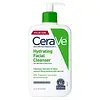What's inside
What's inside
 Key Ingredients
Key Ingredients

 Benefits
Benefits

 Concerns
Concerns

 Ingredients Side-by-side
Ingredients Side-by-side

Gossypium Herbaceum Seed Oil
Skin ConditioningRicinus Communis Seed Oil
MaskingAloe Barbadensis Leaf Juice
Skin ConditioningWater
Skin ConditioningGlycerin
HumectantSorbitol
HumectantCocamidopropyl Hydroxysultaine
CleansingSorbitan Oleate
EmulsifyingIsohexadecane
EmollientDecyl Glucoside
CleansingCocamidopropyl Betaine
CleansingCitrus Aurantium Dulcis Peel Oil
MaskingTetrahexyldecyl Ascorbate
AntioxidantAscorbic Acid
AntioxidantCitrus Unshiu Peel Extract
MaskingLactic Acid
BufferingHippophae Rhamnoides Oil
EmollientPhyllanthus Emblica Fruit Extract
HumectantTerminalia Ferdinandiana Fruit Extract
AntioxidantSqualane
EmollientCamellia Oleifera Seed Oil
Skin ConditioningPrunus Armeniaca Kernel Oil
MaskingHelianthus Annuus Seed Oil
EmollientColloidal Oatmeal
AbsorbentSphingolipids
EmollientPhospholipids
Skin ConditioningSodium Hyaluronate
HumectantSodium PCA
HumectantLecithin
EmollientSilica
AbrasiveSodium Starch Octenylsuccinate
AbsorbentSorbitan Stearate
EmulsifyingPotassium Hydroxide
BufferingLeuconostoc/Radish Root Ferment Filtrate
AntimicrobialSodium Metasilicate
BufferingCitric Acid
BufferingSodium Citrate
BufferingTetrasodium Glutamate Diacetate
Phenoxyethanol
PreservativePotassium Sorbate
PreservativeGossypium Herbaceum Seed Oil, Ricinus Communis Seed Oil, Aloe Barbadensis Leaf Juice, Water, Glycerin, Sorbitol, Cocamidopropyl Hydroxysultaine, Sorbitan Oleate, Isohexadecane, Decyl Glucoside, Cocamidopropyl Betaine, Citrus Aurantium Dulcis Peel Oil, Tetrahexyldecyl Ascorbate, Ascorbic Acid, Citrus Unshiu Peel Extract, Lactic Acid, Hippophae Rhamnoides Oil, Phyllanthus Emblica Fruit Extract, Terminalia Ferdinandiana Fruit Extract, Squalane, Camellia Oleifera Seed Oil, Prunus Armeniaca Kernel Oil, Helianthus Annuus Seed Oil, Colloidal Oatmeal, Sphingolipids, Phospholipids, Sodium Hyaluronate, Sodium PCA, Lecithin, Silica, Sodium Starch Octenylsuccinate, Sorbitan Stearate, Potassium Hydroxide, Leuconostoc/Radish Root Ferment Filtrate, Sodium Metasilicate, Citric Acid, Sodium Citrate, Tetrasodium Glutamate Diacetate, Phenoxyethanol, Potassium Sorbate
Water
Skin ConditioningGlycerin
HumectantCetearyl Alcohol
EmollientPEG-40 Stearate
EmulsifyingStearyl Alcohol
EmollientPotassium Phosphate
BufferingCeramide NP
Skin ConditioningCeramide AP
Skin ConditioningCeramide EOP
Skin ConditioningCarbomer
Emulsion StabilisingGlyceryl Stearate
EmollientBehentrimonium Methosulfate
Sodium Lauroyl Lactylate
EmulsifyingSodium Hyaluronate
HumectantCholesterol
EmollientPhenoxyethanol
PreservativeDisodium EDTA
Dipotassium Phosphate
BufferingTocopherol
AntioxidantPhytosphingosine
Skin ConditioningXanthan Gum
EmulsifyingCetyl Alcohol
EmollientPolysorbate 20
EmulsifyingEthylhexylglycerin
Skin ConditioningWater, Glycerin, Cetearyl Alcohol, PEG-40 Stearate, Stearyl Alcohol, Potassium Phosphate, Ceramide NP, Ceramide AP, Ceramide EOP, Carbomer, Glyceryl Stearate, Behentrimonium Methosulfate, Sodium Lauroyl Lactylate, Sodium Hyaluronate, Cholesterol, Phenoxyethanol, Disodium EDTA, Dipotassium Phosphate, Tocopherol, Phytosphingosine, Xanthan Gum, Cetyl Alcohol, Polysorbate 20, Ethylhexylglycerin
 Reviews
Reviews

Ingredients Explained
These ingredients are found in both products.
Ingredients higher up in an ingredient list are typically present in a larger amount.
Glycerin is already naturally found in your skin. It helps moisturize and protect your skin.
A study from 2016 found glycerin to be more effective as a humectant than AHAs and hyaluronic acid.
As a humectant, it helps the skin stay hydrated by pulling moisture to your skin. The low molecular weight of glycerin allows it to pull moisture into the deeper layers of your skin.
Hydrated skin improves your skin barrier; Your skin barrier helps protect against irritants and bacteria.
Glycerin has also been found to have antimicrobial and antiviral properties. Due to these properties, glycerin is often used in wound and burn treatments.
In cosmetics, glycerin is usually derived from plants such as soybean or palm. However, it can also be sourced from animals, such as tallow or animal fat.
This ingredient is organic, colorless, odorless, and non-toxic.
Glycerin is the name for this ingredient in American English. British English uses Glycerol/Glycerine.
Learn more about GlycerinPhenoxyethanol is a preservative that has germicide, antimicrobial, and aromatic properties. Studies show that phenoxyethanol can prevent microbial growth. By itself, it has a scent that is similar to that of a rose.
It's often used in formulations along with Caprylyl Glycol to preserve the shelf life of products.
Sodium Hyaluronate is hyaluronic acid's salt form. It is commonly derived from the sodium salt of hyaluronic acid.
Like hyaluronic acid, it is great at holding water and acts as a humectant. This makes it a great skin hydrating ingredient.
Sodium Hyaluronate is naturally occurring in our bodies and is mostly found in eye fluid and joints.
These are some other common types of Hyaluronic Acid:
Learn more about Sodium HyaluronateWater. It's the most common cosmetic ingredient of all. You'll usually see it at the top of ingredient lists, meaning that it makes up the largest part of the product.
So why is it so popular? Water most often acts as a solvent - this means that it helps dissolve other ingredients into the formulation.
You'll also recognize water as that liquid we all need to stay alive. If you see this, drink a glass of water. Stay hydrated!
Learn more about Water